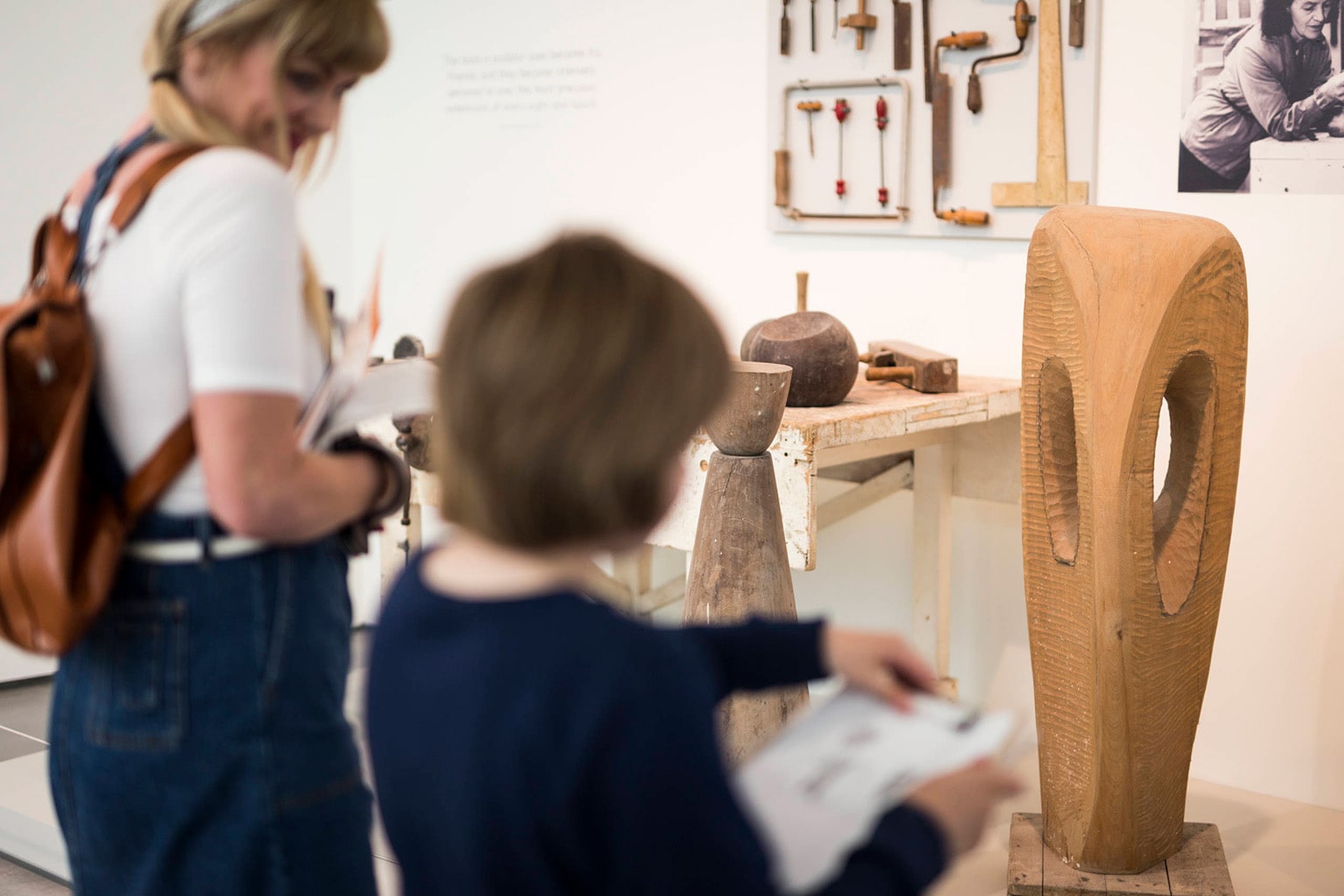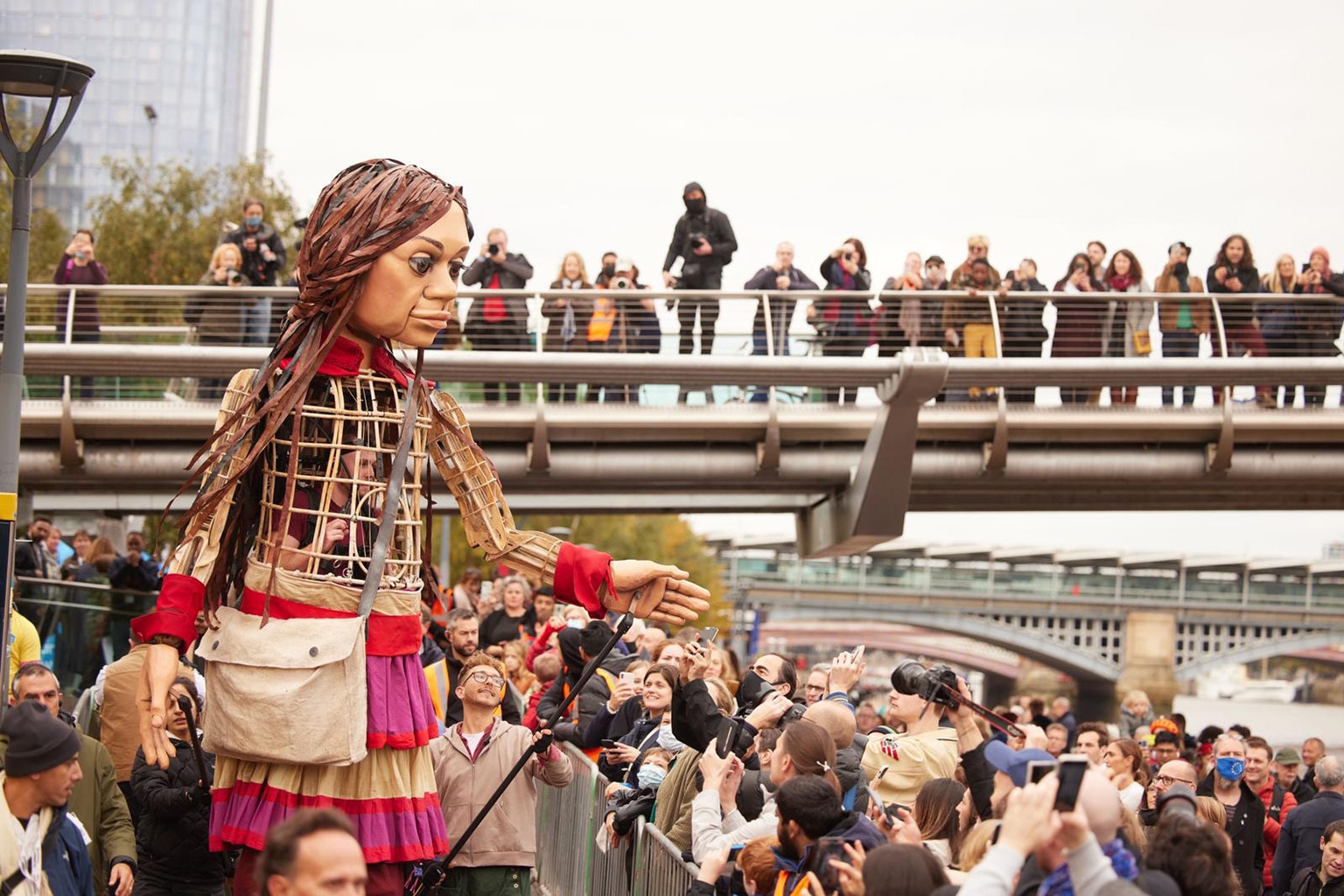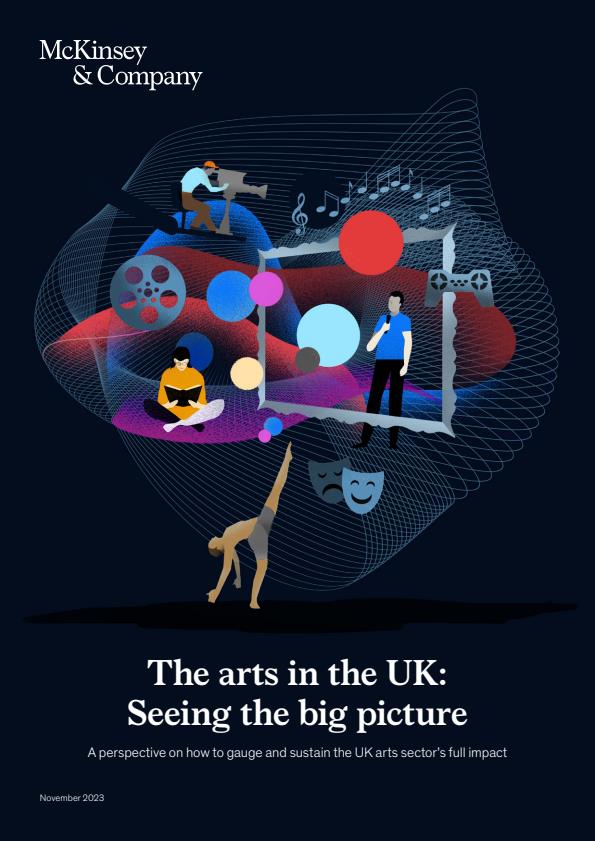People in the United Kingdom engage with the arts on a massive scale. A 2023 survey by DCMS found that some 91 percent of UK adults had done so at least once, in one way or another, during the previous 12 months. Seventy-four percent had attended an arts event such as an exhibition or a theatre performance, for example.1 (The sidebar “Mass engagement” gives a more detailed breakdown.)
Such figures attest to the intrinsic value of the arts. People engage with them because of their ability to entertain, stimulate the senses, and trigger a wide range of emotional responses, from enjoyment and awe to anger and fear. This is the basic premise of art and the primary benefit of engagement.
Recently, the London School of Economics (LSE) conducted a survey asking participants to rank 42 different activities by the relative perceived value they contributed to the participants’ lives. The LSE equated this value with the degree of happiness these activities confer. Being sick in bed, queueing, and commuting were among those with a high negative value. Attending the theatre, singing, and visiting museums were among the most positively valued—second only to sports and intimacy.2
The LSE’s happiness factor is one way of measuring the intrinsic aesthetic value of engagement with the arts. But engagement with the arts has broader impact, which can be measured in three ways (Exhibit 1):
- the impact of the arts on the UK economy—the value of the goods and services the arts sector produces and the number of businesses and jobs it supports
- the impact of the arts on the lives of individuals by helping them to develop new skills or to improve their wellbeing and health
- the impact of the arts on communities: encouraging sociable behaviour, contributing to the attractiveness of local communities, and stimulating discourse

Indeed, the impact of the sector extends beyond even this. It is vital to the creative industries, for example, and contributes significantly to many other sectors of the economy. This indirect impact is explored later in the report.
Direct impact on the UK economy
Many UK arts organisations are not-for-profits: all national museums, for example, must provide free access to all visitors.3 Yet the arts sector makes a significant direct economic contribution to the UK economy, as measured by the economic activity of the 139,000 enterprises active in the sector in 2022. About half were creators, distributors, promoters, or arts educators. The other half were suppliers of products and services.4
The 139,000 enterprises come in many sizes. Ninety-five percent are classified as sole traders or as small enterprises with no more than nine employees. The remaining 5 percent are large (Exhibit 2).5 The British Broadcasting Corporation (BBC), for example, has nine production bases across the United Kingdom.6 According to the BBC’s 2022–23 report, it is the single biggest employer of musicians in the United Kingdom and the country’s single biggest commissioner of new music works, both in number and the amount of money involved.7

In all, the arts employ some 620,000 people. One-third of them are suppliers. A further 350,000 people in the sector are self-employed, for a total of 970,000 (Exhibit 3).8 The proportion of self-employed workers is high compared with other sectors in the UK economy. So is the proportion of part-time workers (see sidebar “Comparison with other sectors”).9

Note that the sector’s 139,000 enterprises do not include voluntary leisure-based arts organisations, including leisure-based choirs and theatres and (for example) sculpting and painting classes.10 The United Kingdom has some 63,000 such organisations, many run by volunteers.11
The total revenues of arts enterprises reached £140 billion in 2022, 40 percent of it generated by suppliers of products and services. This translated into a total gross value added (GVA)—a measure of the value to the economy of the goods and services a sector produces—of £49 billion, including the £20 billion contribution by suppliers. That equals 2.2 percent of the national GVA.12 To put this sum in context, it’s similar to the GVA of the food and beverage services sector and 50 percent bigger than the GVA of the telecommunications industry (Exhibit 4).13

Direct impact on individuals
The number of individuals who engage with the arts attests to their value as a source of entertainment and emotional stimulation. Beyond this, however, engagement with the arts can also have two tangible positive impacts on the lives of individuals: improving their skills and educational outcomes and improving their wellbeing and health.


Skills and educational outcomes
Engagement with arts activities can help individuals develop a broad range of core skills, including memory, problem-solving, spatial–temporal performance, and executive function.1 It can also boost the self-confidence of children. One University College London (UCL) study found that those who took part in arts activities scored from 16 to 32 percent higher on questions related to self-esteem than those who did not.2
Engagement with the arts can help improve educational outcomes, as well. The Cultural Learning Alliance (CLA), for example, found that participating in structured art activities could boost young people’s attainment in literacy and maths and increase their cognitive capabilities by 17 percent.3
In fact, the recognised impact of the arts on educational outcomes is so strong that the Welsh government, in partnership with the Arts Council of Wales, introduced the Creative Learning Through the Arts programme in schools across the country.4 The aim was not only to improve children’s experience of the arts but also to implement the curriculum more creatively by drawing in professionals such as musicians, writers, actors, and dancers.
What was the result? Teachers found that students’ attainment across the five “creative habits of mind”—inquisitiveness, persistence, collaboration, discipline, and imagination—improved, on average over a four-year period, by six on a scale of one to ten (ten means a significant improvement).5
Wellbeing and health
Perhaps most easily understood is the impact that engagement with the arts can have on individual wellbeing. UCL’s Arts, Culture & the Brain report (commissioned by Arts Council England) drew on findings from the Understanding Society survey of more than 100,000 people. The report concluded that attending arts events and venues correlates with greater happiness and a positive mood.1 Listening to music, drawing, and writing as hobbies have a similar impact, the report noted: such activities can reduce stress levels by providing distractions from negative or irrational thoughts and emotions.2
The arts have been shown to influence health conditions as well. UCL’s Social Biobehavioural Research Group conducted a major cohort study in the United Kingdom and the United States. It found that people over the age of 50 who visited cultural venues every few months had a 32 percent lower risk of developing depression over a ten-year period.3 In addition, music-based interventions—group singing or drumming or listening to music, for instance—have been found to help manage depression and to help prevent other conditions, such as dementia.4 Music activities can also improve balance, lung function, speech, and other physical functions in patients with Parkinson’s disease.5
Recognizing the link between participation in the arts and improved wellbeing and health, the National Health Service (NHS) has now made art activities part of a social-prescribing programme: health professionals help patients to manage their conditions by, for example, attending poetry clubs, painting classes, or many other (often community-based) arts events.6 The ambition is to prescribe arts and other activities for more than 900,000 people by 2023–24. That goal will require substantial support from arts organisations and practitioners.7
Many of them already work with NHS trusts and healthcare providers. For 15 years, Royal Liverpool Philharmonic has been partnering with NHS Trusts, including original partner Mersey Care NHS Foundation Trust, for example. They support patients with a range of physical- and mental health conditions by offering them person-centred music activities and helping them attend performances and events at Liverpool Philharmonic Hall. The longevity and growth of the programme, and the number of patients benefitting from it—18,000 to date—point to its success.8
In another such programme, the not-for-profit Artlift set up a scheme with nine GP surgeries in Gloucestershire: patients suffering from conditions such as depression, anxiety, chronic pain, and stroke were offered the chance to sign up for an eight-week course led by a professional artist working in poetry, ceramics, drawing, mosaics, or painting. The resulting health benefits were significant. In the year after the programme, GP consultation rates dropped among those taking part by 37 percent and hospital admissions by 27 percent relative to the previous year—equivalent to a saving of £216 per patient.9 Artlift now runs similar schemes in partnership with the NHS.
Direct impact on communities
Engagement with the arts can have a positive impact on local communities and on the wider society in three ways: by encouraging sociable behaviour, making local communities more attractive places to live, and stimulating discourse.



Sociable behaviour
Engagement with the arts can encourage sociable behaviour in several ways, such as fostering tolerance, compassion, and empathy. ArtsEkta, a cultural organisation in Northern Ireland, led some 440 arts workshops, attended by 13,000 participants, for a year in 2022–23. The goal was to promote multicultural engagement. Of those who participated, 82 percent said they came into contact with someone from another ethnicity, and 92 percent said they had greater appreciation of another culture as a result.1 In a pilot US study, medical students took a one-month course each year on art observation and reflective practice. Eighty percent of the participants improved their perspective taking—the ability to understand how a situation might feel or appear to another person.2
Engagement with the arts can also encourage individuals to play a more proactive role in society. A literature review by the CLA found that students from low-income families who participated in the arts at school were twice as likely to undertake voluntary work and 20 percent more likely to vote as young adults.3
Numerous studies have also shown that participation in arts programmes may help reduce levels of antisocial behaviour. The CLA, for example, found that young offenders who participated in such programmes were four times more likely to be highly engaged with education and training or to be employed post-programme and 18 percent less likely to reoffend upon release.4 And reports indicate that an Artist in Residence scheme at HMP Grendon, which runs therapy programmes to help inmates understand and address their patterns of offending, promoted a sense of group cohesion that improved the prison environment and helped inmates to redefine themselves.5 The programme has run since 2009.
Place-making
A thriving arts sector plays an important role in what is often termed place-making—creating more attractive communities where people want to live, work, and do business. That in turn makes these communities more prosperous. One reason is that engagement with the arts improves social connections. Some 82 percent of respondents in a large-scale qualitative survey by the Centre for Performance Science, for example, reported that artistic engagement (particularly live music events and theatre performances) made them feel more socially connected.1
In addition, a thriving arts sector can help foster a sense of pride in local communities. One survey showed that nearly 90 percent of Edinburgh residents felt that its annual festivals increased their pride in the city.2 Helping people feel proud of the places where they live is among the main aims of the government-funded High Streets Heritage Action Zone initiative, which is investing in cultural activities on local high streets over four years.3 The aim is to make them more attractive, engaging, and vibrant places to live, to work, and to spend time.
Finally, a thriving arts sector can contribute to place-making by promoting greater economic prosperity in a community. When the Hepworth Wakefield opened, in 2011, it was the only cultural centre or visitor attraction of any kind in a town with high levels of deprivation. By 2019, the art museum was attracting some 200,000 visitors annually and played an important role in encouraging Tileyard, already a major provider of music and creative studios in the United Kingdom, to develop a creative hub in the city.4
Another example, HomePlace, is an arts and literary centre in Bellaghy, Northern Ireland. It is dedicated to the Nobel Prize–winning poet Seamus Heaney, who was born in the village, which has fewer than 2,000 people. Yet in the centre’s first year of operation, in 2016, it welcomed more than 40,000 visitors. HomePlace now has annual revenues of around £800,000 and supports more than 20 employees.5
Thriving arts organisations can also have a positive impact on local communities in large cities. The Southbank Centre, along with other arts organisations, such as the National Theatre and British Film Institute, has played a pivotal role in the long-term regeneration of London’s South Bank area, for example. In 2018–19, it contributed to the vibrancy of the area by attracting a total footfall of 31.7 million, by mounting a public-festivals programme that attracted an audience of 42,800, by hosting 64 commercial partners on-site, and by reaching 13,600 students in the local area, including a 50 percent penetration rate in local schools. An “open foyer policy” provides an inclusive community space from 10 a.m. to 11 p.m. daily, attracting professional workers, students, homeless people, and social groups.6
Such is the contribution the arts can make to place-making that some communities are working to create thriving arts venues. Wigan Council, for example, is currently turning Haigh Hall into a beacon for the arts, culture, heritage, and the environment through the Haigh Hall 3-H: humanities, hospitality, and horticulture. The project’s master plan, inspired by local people, includes a space to ignite children’s creativity through collaboration with artists-in-residence, writers, and poets, among others.7
The annual festive market in Wakefield organised by the Hepworth Wakefield in collaboration with Tileyard. Photo by Nick Singleton.
Discourse
The arts can raise awareness of sociopolitical issues by making powerful statements that encourage discourse and reflection. The Understanding the value of arts & culture report, for instance, discusses how art can provide a safe and contained space for reflecting on issues and creating ”reflective individuals.”1 Examples of art that seeks to raise awareness abound.
Much art seeks to raise awareness of sociopolitical issues:
- The award-winning film Aftersun (2022), directed by Charlotte Wells, examined men’s mental health and intergenerational trauma. It became the United Kingdom’s highest-grossing independent debut film since 2011 and the most streamed release globally on the platform Mubi.2
- The 2018 Ice Watch project was an art installation by Icelanders Olafur Eliasson and Minik Rosing. It raised awareness of climate change by grouping immense blocks of ice, harvested from a fjord in Greenland, outside the Tate Modern art gallery in London.3 The blocks melted away.
- A 2021 performance art project by the Walk Productions drew attention to the plight of child refugees. Little Amal, a 12-foot puppet of a ten-year-old Syrian refugee child, undertook a 5,000 mile “walk” across 13 European countries. More than one million people watched her journey in person and tens of millions more online.4
Little Amal during her walk in the UK. Photo by David Lan.
Read the next chapter: Five connections that underpin the impact of the UK arts sector.


